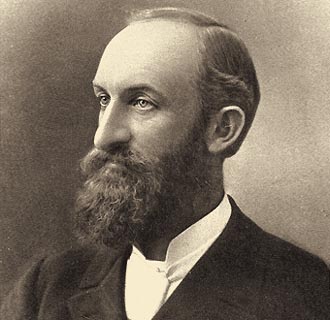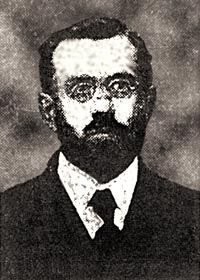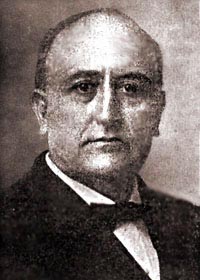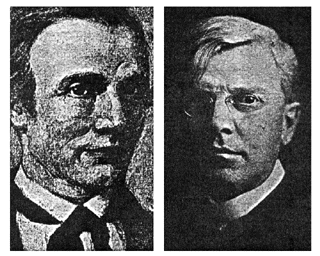
READINGS IN EARLY MORMON HISTORY
(Newspapers of Ohio)
Misc. Ohio Newspapers
1910-1999 Articles

Mormon Church President Heber J. Grant
1800-29 | 1829-31 | 1832-34 | 1835-39 | 1840-49
1850-59 | 1860-79 | 1880-99 | 1900-09 | 1910-99
1910-1939
CPD May 07 '10 | MNews Jul 01 '11 | MDis Dec 04 '14 | CStd Mar 16 '15 | CPD Apr 04 '15
CStd Jul 03 '15 | CStd Sep 25 '15 | CPD May 07 '22 | JfGz May ?? '24 | JfGz 1925?
CPD Mar 15 '27 | JfGz ?? 1927 | ZTR Jan 01 '30 | ZTR Sep 21 '36
1940-1999
ASB Aug 18 '40 | CPD Jun 12 '41 | CPD Jun 17 '41 | CPD Jun 18 '41 | CPD Jun 20 '41
CPD Jun 23 '41 | CPD Jun 18 '41 | CPD Nov 09 '41 | CPD Mar 05 '50 | ECT Jul 12 '58
CPD Dec 27 '64 | ZTR Jul 06 '69 | EC Aug 10 '77 | RC Dec 20 '86
2000s
RC Mar 25 '07 | StarB Mar 13 '11
Articles Index | Painesville Tel. | Painesville Rep. | Gazette/Spec.
 Vol. 69. Cleveland, Ohio, Saturday, May 7, 1910. No. 127.
MORMON PRIEST IS
Tiffin, O., May 7. -- Charles J. Yingling, wealthy merchant of Tiffin, has in his possession a book upon which one of the religious disputes of the age rests. The little volume is an old minute book of the Methodist Protestant church. On it anti-Mormonists are basing claims that the Book of Mormon is a colossal fraud. |
Vol. 27. Mansfield, Ohio, Saturday, July 1, 1911. No. 100.
MANSFIELD'S GROWTH
|
Vol. ? Canfield, Ohio, Friday, December 4, 1914. No. ? THE SON OF A PROPHET. The serious illness of Joseph Smith, president of the Church of Jesus Christ of the Latter Day Saints one of two branches of the Mormon church in America, recalls that Monmonism as a religious faith had its inception in the East. The father of Joseph Smith and of the same name, was the founder of Mormonism. He was known as Joseph Smith tho prophet |
Vol. 50. Cincinnati, March 16, 1915. No. 23. THE TACTICS OF MORMONISM. CHARLES A. SHOOK. Author of "Cumorah Revisited," "The True Origin of Mormon Polygamy," "The True Origin of the Book of Mormon," etc., etc. Published by The Standard Publishing Company, Cincinnati, O. 
C. A. SHOOK. The Church of Jesus Christ of Latter-day Saints, so called, was founded by Joseph Smith, the Mormon "prophet," at Fayette, Seneca Co., N. Y., Apr. 6, 1830, with six members. From this small beginning it continued to grow until, at the time of its prophet's death in 1844, there were twenty thousand Mormons in Nauvoo, Ill., and vicinity, who are declared to have been the "great bulk of the Saints" in the United States, and 7,797 in the British Isles. According to the statistics compiled by Dr. Carroll in 1913, there were 356,000 Latter-day Saints in this country, with 3,560 ministers and 2,520 churches, a gain for the year of 3,500 communicants, 200 ministers and 100 churches. |
 Vol. ? Cleveland, Ohio, April 4, 1915. No. ?
MORMONISM BORN IN OHIO?
Over in Lake county, down in the valley, there is a clump of houses and a few stores. This is called Kirtland. Right in the midst of Kirtland stands a temple of Mormonism, the first Mormon temple ever established. And scattered through Lake and Ashtabula counties there are Mormons by the hundreds who still meet in this temple. |
Vol. 50. Cincinnati, July 3, 1915. No. 40. WAS SIDNEY RIGDON THE ORIGINAL "AUTHOR" AND PROPRIETOR" OF THE WHOLE MORMON CONSPIRACY? R. B. NEAL. 
R. B. NEAL. When was "Mormonism" planted on earth? |
Vol. 50. Cincinnati, Sept. 25, 1915. No. 52. Neals' Notes. I would gently remind a number of the members of the Gospel Dollar League that their dues are long past due, and the money is badly needed... |
 Vol. ? Cleveland, Ohio, Sunday, May 7, 1922. No. ?
DID MORMON ELDER
TIFFIN, O., May 6. -- Did Oliver Cowdery, second elder of the Church of Jesus ChrIst of Latter Day Saints and coworker of Joseph Smith, prophet and founder of that church, renounce Mormonism? |
Vol. ? Jefferson, Ashtabula Co., Ohio, May ?, 1924 No. ?
THE INDIANS AND MOUND BUILDERS
|
Vol. ? Jefferson, Ashtabula Co., Ohio, 1925? No. ?
MORMON BIBLE ORIGINATED
When the first settlers came to Conneaut, then called Salem or New Salem, they found many evidences of a large population that once inhabited that section. There were mounds or fortifications made by a race long before extinct. There was a grave yard in which were over 3000 graves. |
 Vol. ? Cleveland, Ohio, Tuesday, March 15, 1927. No. ?
RANSACKS ATTICS,
[Edward C.] Lampson attended Western Reserve university for a time, but quit to edit the Gazette when his father, who owned the paper, was appointed reading clerk in the House of Representatives at Washington. |
Vol. ? Jefferson, Ashtabula Co., Ohio, ??, 1927 No. ?
ASHTABULA CO. HAS BEEN HOME
It was the Rev. Mr. Badger, a native of Connecticut, who on October 24, 1801, organized a Congregational church at Austinburg (Ashtabula Co.) which was the first religious society on the Western Reserve.... |
Vol. XLVI. Zanesville, Ohio, Wednesday, January 1, 1930. No. 1.
High Spots in Ohio History
A rather imposing monument in the cemetery at Circleville marks the grave of a man who though notable enough in his day, needs an introduction to the present generation -- John Cradlebaugh. He was a native of that city, born in 1819; became a lawyer,and in 1852-53 represented that senatorial district in the legislature. In 1858 he took an active part in the campaign for James Buchanan and was rewarded by Buchanan by appointment as U. S. judge for the territory of Utah. In that capacity he greatly interested himself in trying to bring the persons guilty of the Mountain Meadow massacre to justice, but he did not have such support as he might expect from the president, and his efforts failed. There was a break between him and the president and the Civil war coming on. Cradlebaugh returned to Ohio and organizing the 114th Ohio Volunteers Infantry, commanded it. Receiving a bad wound in the mouth, his retirement was forced and he went west again, this time locating in Nevada, and was sent by that territory as its delegate to congress. He had hoped to be one of the new state's senators, but wealthy men from California put him out of the running. He died in Nevada in 1872, a poor man, his wound interfering with his speech so that he could never speak plainly again, and could not practice law. |
Vol. ? Zanesville, Ohio, Monday, September 21, 1936. No. 226.
HIGH SPOTS IN OHIO HISTORY
Quick suspicion on the part of people living in Portage county in the early thirties led to the establishment of the first organization of the Mormon church in this state in Lake county (Kirtland) instead of at Hiram, in Portage county. In the winter of 1831, Joseph Smith and Sidney Rigdon came from near Palmyra, N.Y., where they had been pushing their new religion in the face of some persistent opposition. They did have some success in getting converts to their religion at Hiram but presently it was rumored the the projectors of Mormonism were arranging it so that the property of their converts would pass into the hands of their new church. |
Vol. ? Ashtabula Ohio, Aug. 18, 1940 No. ? ORIGINAL BOOK OF MORMON. Many believe, and historical evidence supports a claim that the original Mormon Bible was written by a Conneaut forge owner, Solomon Spaulding. Such origin, however, is disclaimed by adherents of the Mormon faith. |
 Vol. 100. Cleveland, Ohio, Thursday, June 12, 1941. No. ?
Kirtland's Mormon Temple and its Builders
Familiar with the region about the Mormon Temple at Kirtland, nearly 50 years ago I stood in the main auditorium on the ground floor. It was Sunday afternoon.Light from its windows illuminated the pillared hall. I believe I can describe that interior from memory and give my impressions of that first visit with the aid of a few facts since gathered. |
 Vol. 100. Cleveland, Ohio, Tuesday, June 17, 1941. No. 168.
Early Days of the Mormons in Kirtland
At Kirtland, 20 miles from the Public Square as the crow flies, was established the first permanent settlement of the Mormons. In its valley and on its hills more than a century ago, was made the first strong stand of a new religion. |
 Vol. 100. Cleveland, Ohio, Wednesday, June 18, 1941. No. 169.
How Sidney Rigdon Was Converted
Sidney Rigdon suddenly converted to the Mormon faith at Mentor in 1830 by visiting e1ders, played a long and dramatic part in the fortunes of the sect that elevated him to a position almost equal to that of Joseph Smith and Brigham Young. For nearly fifteen years he figured in its waves of prosperity and tragic occurrences. Twice sentenced to be shot by troops in religious clashes, he rose high in church councils. It is said that he prayed and wept at night on the walls of the Kirtland Temple that it might be completed. Ten years later, expelled from communion by the Mormons, he formed an organization of his own, published a paper attacking polygamy and lived until the mid '70s. |
 Vol. 100. Cleveland, Ohio, Friday, June 20, 1941. No. 171.
First Mormon Converts
Sidney Rigdon was baptized a Mormon on Nov. 14 [sic - 8th?], 1830, according to Mrs. Lyman Wight, whose husband was a member of a "common stock society," formed in Kirtland before the elders came to Mentor. She says that he was baptized in the "Shageen (Chagrin) River, at Kirtland." |
 Vol. 100. Cleveland, Ohio, Monday, June 23, 1941. No. ?
Sidney Rigdon and the Early Mormon Church
In the two months that the Mormon elders -- Pratt, Peterson, Cowdery and Whitmer -- remained around Mentor, they visited Sidney Rigdon and ordained him an elder. During the autumn weeks the missionaries were there, they went from house to house exhibiting their Bible and making converts throughout the fall of 1830 -- even into the winter -- crowds visited Kirtland where the religious excitement centered Baptismal rites were celebrated and a Mormon congregation formed. On Sundays, roads were thronged with people in vehicles, on horseback, out on foot, pressing forward to learn particulars of the new faith. |
 Vol. 100. Cleveland, Ohio, Saturday, June 28, 1941. No. ?
When the Mormons Came to Kirtland
In late January, 1831, Prophet Joseph Smith, jr., with his wife, Emma Hale Smith, Sidney Rigdon and Edward Partridge set out from Fayette, N. Y., for Kirtland, arriving about Feb. 1. This was in obedience to a revelation received by Smith a month before. They stopped at the frame combination home, store and postoffice of Newel K. Whitney in Kirtland Village. There were several churches, a brick hotel, the near-by common-stock family of nearly 100, and a scattered town. In the words of the prophet, the party "were kindly received and welcomed into the house of Brother Whitney. I and my wife lived in the family of Whitney several weeks." |
 Vol. 100. Cleveland, Ohio, Sunday, November 9, 1941. No. ?
Ohio Songs and Citizens
|
 Vol. ? Cleveland, Ohio, March 5, 1950. No. ?
Ohio Scenes and Citizens.
In the dignified and inviting library of Oberlin College, Oberlin, O., the most famous volume is a battered manuscript that has been the cause of bitter controversy for more than a century. Kept securely behind locked doors, is a novel written about 1810 by Rev. Solomon Spaulding, Conneaut, O. For years it has been tagged by non-Mormons as the basis of the Book of Mormon, a claim violently denied by all followers of the Prophet Joseph Smith. |
Vol. ? Elyria, Ohio, July 12, 1958. No. ?
3 Elyria Churches Pioneer in Religious
What kind of a place was Elyria where religion was concerned at the time of its incorporation in 1833? |
 Vol. ? Cleveland, Ohio, Sunday, December 27, 1964. No. ?
tar, feathers and revelation
It is a startling chapter in Ohio annals, the violent happenings in the shiny white house that so tranquilly faces Pioneer Trail on the edge of Hiram. Though face-lifting camouflages its age, the house is full of years. Events that make it world famous took place in it in 1831, when the young Joseph Smith was launching his new religion, Mormonism. Old, too, is the road in front that wanders leisurely west to Aurora along a scenic ridge, a route followed by frontiersmen and before them by Indians and buffalo. |
Vol. ? Zanesville, Ohio, Sunday, July 6, 1969. No. ?
Conducted Meetings in Front of Courthouse A prophet with a long beard and flowing robe pounded his shepherd's staff on the ground with every step as he walked down Zanesville's Main street in 1817. Like all his followers in wagons and on foot he wore a bearskin girdle as a symbol of his sect. |
Vol. ? Elyria, Ohio, Wednesday, August 8, 1977. No. ? Book of Mormon faces a tough new challenge A rhetorical flurry has arisen over this month's announcement in the prestigious religious publication Christianity Today, that three young southern California researchers have uncovered evidence challenging the validity of the Book of Mormon, long called the "keystone" of faith by leaders of the 3.8-million-member Mormon Church. |
Vol. ? Kent & Ravenna, Ohio, Saturday, Dec. 20, 1986. No. ?
PORTAGE PATHWAYS:
The Portrait, an 1874 novel, was written by Albert Gallatin Riddle. Was it really an almost tearful, moving recollection of his own early life as a bright and sometimes misunderstood and tormented youth on the Mantua frontier? The slices of life as lived by the book's hero, Fred Warden, who grew into manhood as a brilliant lawyer and political orator, closely parallel Riddle's own career. |
Vol. ? Kent & Ravenna, Ohio, Sunday, March 25, 2007. No. ?
PORTAGE PATHWAYS:
One of the most shameful episodes in Portage County's history occurred 175 years ago today on a farm in Hiram Township, where a dispute fueled by religious differences escalated into a near-lynching. |
Vol. ? Conneaut, Ohio, Sunday, March 13, 2011. No. ?
Conneaut Artifacts Inspired
Two centuries of civilization have destroyed the mysterious mounds and graveyards that settlers to Conneaut found near Conneaut Creek. Solomon Spaulding, while walking this area in 1809, claimed in his book 'Manuscript Found' to have discovered the entrance to a cave containing scrolls, one of which told the story of the ancient civilization, a lost tribe of Israel. Conneaut residents, who heard Spaulding spin his tales as he wrote a book called 'Manuscript Found,' would later testify that the Book of Mormon story and language paralleled the one Spaulding read to them. What became of the manuscript that Spaulding read from is a mystery; some say it fell into the hands of Sidney Rigdon. |
Back to top of this page.
Articles Home Page | Newspaper Articles Index | History Vault
Oliver's Bookshelf | Spalding Studies Library | Mormon Classics
last updated: Sept. 15, 2013
